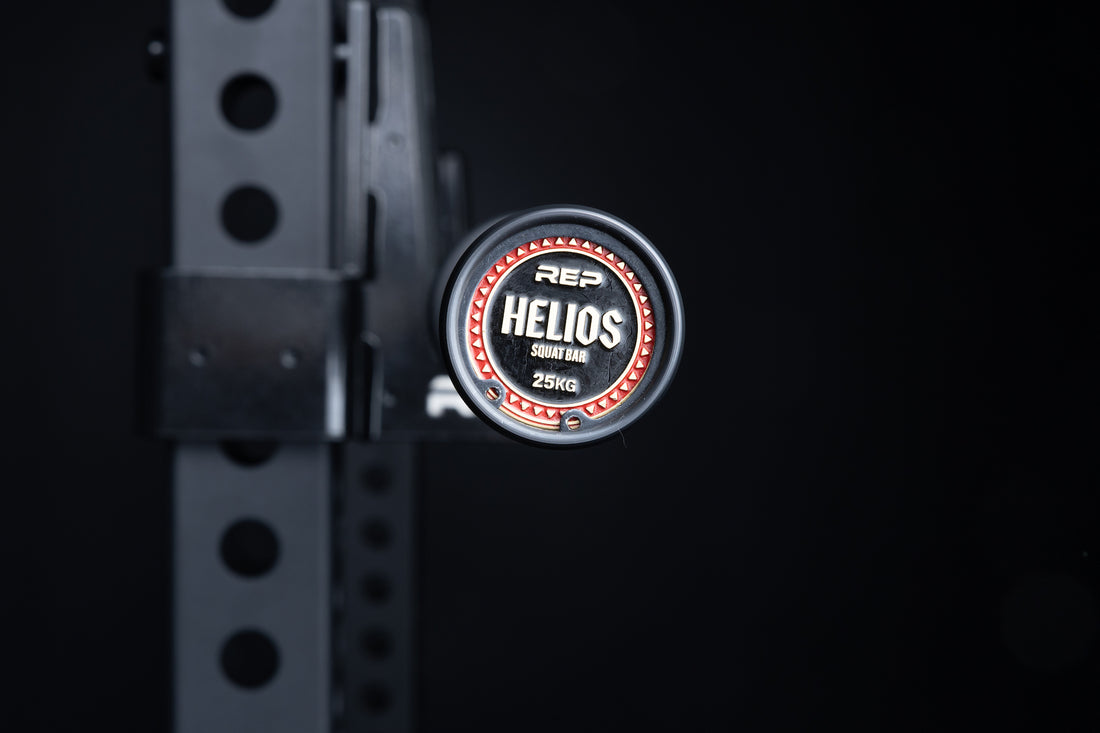
It’s longer. It’s heavier. It’s wider. This specialty bar is made just for squats.
Can’t you just squat with any barbell? Sure, you could. (Although a heavy squat with a whippy deadlift bar with no center knurling might turn you into a gym meme, if you make it out unscathed.) (On second thought, please don’t.)
Now, regular barbells with center knurling – that's to help hold the bar in place on your back – are perfectly excellent for squatting. That’s why many associations use a standard power bar for back squats.
But there comes a time and a place for a special squat bar.
First, what the heck is a squat bar?

A squat bar, like the Helios Squat Bar, features a longer length (94.5" or 7.9’). The squat bar’s shaft is also wider, at 32mm (1.3”) and it weighs about 55lbs, rather than 44-45lbs. The Helios bar also has a fully knurled shaft and bushing sleeves. The full knurl keeps it locked onto your back no matter what. Bushing sleeves are best for slower, strength-focused movements.
Is a Squat Bar the Same as a Safety Squat Bar?

A squat bar is different than a safety squat bar. The Safety Squat Bar has knurled handles that bring your hands in front of your body, which can be easier on the shoulders, elbows and wrists. REP’s Safety Squat Bar also has cambered ends that distribute the weight differently than a standard barbell, forcing you to remain more upright during squats. A Safety Squat Bar is heavier, too, at 68lbs.
You wouldn’t see a Safety Squat Bar in a sanctioned meet. It’s for training.
Learn more about safety squat bars here:
- Why You Should Add a Safety Squat Bar to Your Home Gym
- Specialty Barbells: How to Use Them -- And Why
Why Use a Squat Bar?

First, you may be required to use a squat bar in competition. For example, the United States Powerlifting Association (USPA) gives meet directors the option to use either a 20kg power bar or a 25kg squat bar during any squat flight. Many other associations also use a squat bar: WRPF, UPA, APF, APA, IPL.
Typically, the USPA only uses a squat bar for the heavier weight classes in competition, and for good reason. These are the same reasons you may want to train with a squat bar, regardless of whether you are a heavyweight lifter in the USPA or a weekend warrior.
The Benefits of a Squat Bar
- The longer length prevents the weight plates from hitting the power rack uprights while racking or unracking the bar. This allows you to position your hands outside the rack uprights, a common position for larger lifters. So, it can save your knuckles, too.
- The thicker diameter adds rigidity to the bar and minimizes whip/flex during heavy loads for a more stable squat. A whippy squat can be a nightmare to control. This flex can be more pronounced with heavy weight that can cause the bar to bend a little. A downward flex at the bottom of a heavy squat can make the weight feel heavier.
- The full knurling ensures maximum points of grippy contact with your back, rear delts, and traps to create the most secure connection possible to the bar. One of the scariest things when you’re doing back squats is to feel the bar slipping down your back and out of position.
- Bushing sleeves also reduce spin, ideal for slower, strength-focused, powerlifting lifts.
The squat bar is all about adding stability and rigidity to the lift.
Do I Need a Squat Bar?

If you are a brand-new lifter still mastering light weight, you might want to start with a standard 20kg barbell with center knurling (especially since the squat bar is heavier unloaded).
Due to its extra stiffness, a squat bar can be a little (or lot) less comfortable, especially on your shoulders and elbows, for people with mobility limitations. But the solution to that isn’t to just avoid the exercise. Instead, regularly work on your mobility. You can use a PVC pipe and Pull-Up Bands to help work your way there.
If you’re an experienced lifter slapping hundreds upon hundreds of pounds on the bar – enough that you can feel or even see the bar flexing – do yourself a favor and upgrade to a bar that’s tough enough for you.
If you’re a competitive powerlifter in an association that may use the squat bar, prepare yourself in training so you don’t encounter an ugly surprise on the platform with all eyes on you.
If you’re in between noob and King of the Lifts? Give it a try. Even if you don’t need to worry about the whip or the USPA, you’ll appreciate the extra security from a fully knurled bar. And you won’t need to upgrade as you get stronger; you’ll already be well-versed on this ride.
similar to this

NEWSLETTER SIGNUP
Product launch information, promotions, blogs, and REP news.








